It seems that our fears of animals are based around two main themes; there are those with the big pointy teeth that are just looking for an excuse to eat us alive and there are those that, whilst seemingly innocuous, pack a secret weapon so deadly that half the world seem to have a phobia about them. These are the most venomous animals and they deliver lethal toxins through their bites and stings.
Unlike many of the factors involved in ranking the most dangerous animals to man, the strength of venom can and has been measured. This is recorded as the LD50 (median lethal dose)[1] which basically tells us how much is required to kill an average human (or mouse). The most powerful of these natural toxins are nearly 1,000 times more deadly than poisons such as arsenic and cyanide.
Venomous or Poisonous
Now there seems to be a good deal of confusion about whether an animal is venomous or poisonous. Venomous creatures are often described as poisonous and vice versa. Both types have toxins, and both types can be considered dangerous, where they differ is in how they deliver this. Poisons require the victim to ingest/eat them, or can be absorbed through the skin when touched. However, a venom is injected into the victim by means of a bite or a sting [2].

So, animals such as the golden poison dart frog and puffer fish posses some of the most lethal toxins in nature but are poisonous, not venomous. The animals we are looking at here are all venomous and actively inject their toxins. To me this seems a whole lot more sinister and probably goes some way to explaining why photos of puffer fish make people laugh, whereas not many people find a tarantula amusing…
So without further ado let’s have a look at some of the most venomous animals in the world…
Most Venomous Insects
Whilst, in theory at least, there aren’t any insects capable of killing you with a single sting (unless you are allergic), there are a few insects able to give you a sting so painful that you may wish you were dead! To a large extent we have to thank the work of Dr Justin Schmidt for helping us quantify the amount of pain these venomous minibeasts can deliver [3]. He voluntarily allowed himself to be stung by a whole range of insects and whilst writhing around the floor also managed to record a detailed description of the sting. In doing so he created the Schmidt Pain Index which starts at 0 for no pain and finishes at 4 for “want to die” painful. Just to give you an idea, normal wasp and bee stings rate around 2 on the scale.
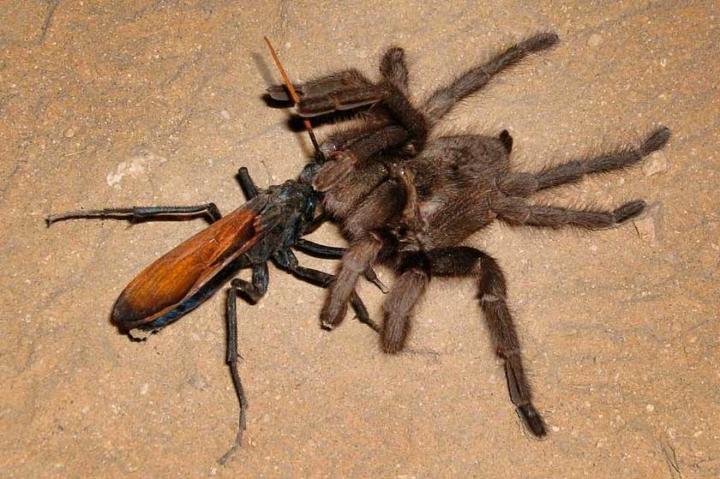
To prove his fearlessness Schmidt allowed himself to be stung by a wasp the size of a helicopter – the Tarantula Hawk. Yes this monster lives off spider meat and is not afraid of tackling the biggest and hairiest of them all. With a sting measuring up to 1/3 in (8mm) long this is one of the largest wasps on Earth.
Unsurprisingly the sting rated a 4 on the index and Schmidt, meaning the pain was “…immediate, excruciating pain that simply shuts down one’s ability to do anything, except, perhaps, scream…”. He also described the sting itself as “Blinding, fierce, shockingly electric. A running hair drier has been dropped into your bubble bath.”
However, Schmidt hadn’t bargained on the Bullet ant sting. This turned out to be so painful that he had to make a new rating on his scale. The sting of this, admittedly large, Central American ant was given a 4+ on the scale. Apparently the pain was so intense that after enduring the pain for a short time Schmidt rushed off to find the nearest tavern and began drinking. 12 hours later he was still suffering significant waves of pain.
Most Venomous Spiders
The Brazilian wandering spider is widely considered the most dangerous spider on the planet. As the name suggests it likes to wander and is well known for turning up in shoes, cars and even hitching a lift across the world on bunches of bananas.
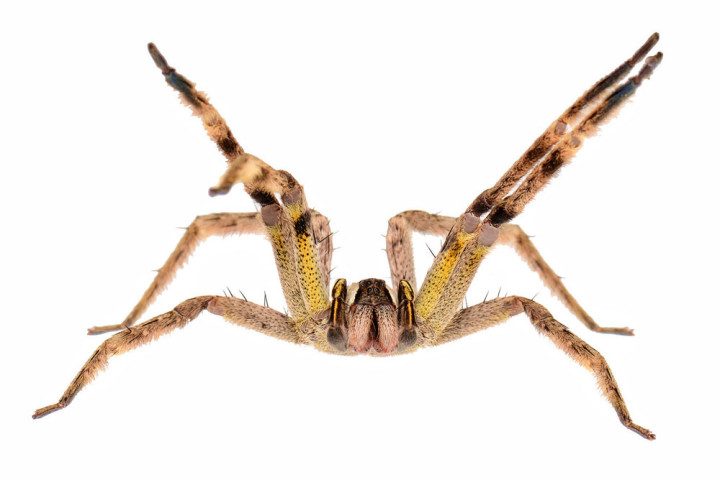
What makes this spider so dangerous though is its venom which according to Guinness World Records is the most powerful of any spider. This deadly neurotoxin is around 20 times more powerful as that of the notorious Black Widow spider and equal in strength to the venom of some deadly snakes. The results of being bitten by the wandering spider begin with intense pain and can prove fatal due to respiratory paralysis and asphyxiation [4]. A less serious, but apparently painful, symptom is that men bitten by this spider may get an erection that lasts several hours!
Vying for top position as the most dangerous spider is the Sydney Funnel Web. This intimidating arachnid is notorious along Australia’s East coast for its fearsome fangs and potent atraxo-toxin. This spider’s venom is reputedly twice as deadly as cyanide and works by attacking the nervous system preventing nerve impulses from being switched off. Symptoms include breathing and circulatory problems, muscle spasms, tears, drooling, vomiting, diarrhoea and possibly death [5].
Possibly the most infamous of all spiders, the Black Widow (and it’s close relative the Australian Redback), is responsible for more bites than any other spider. Up to 10,000 bites a year are recorded in Australia [6] and one of its favourite places to lurk is under the seats of outdoor toilets! The venom of these spiders is second only in strength to that of the Brazilian wandering spider and it is only down to the Black Widow’s small size that it hasn’t caused more deaths. As well as the painful bite a secondary condition known as latrodectism can result from the bite. This potentially fatal condition causes symptoms such as swelling, abdominal cramps, nausea and sweating.
There is some good news for all you arachnophobics out there; effective anti-venoms have been developed for all these spider bites.
Most Venomous Scorpions
There are around 1,500 species of scorpion and all of these possess venom which they deliver via a sting at the end of their tails. However, only about 20 of these species have venom that is potentially deadly to humans and most of these are from a single family, Buthidae. [7] Unfortunately these bad boys of the scorpion world give the rest a bad name; in North America scorpions are responsible for more deaths than snakes and in Tunisia it is estimated that the Fat-tailed scorpion historically caused up to 400 deaths a year.
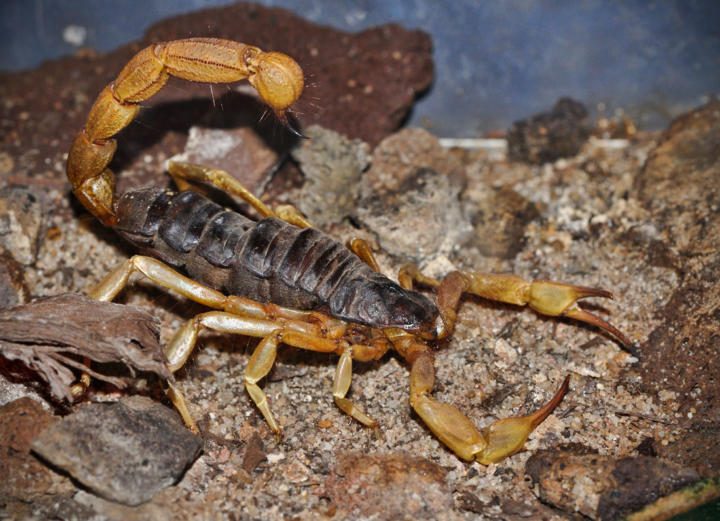
The figures above give a hint as to what may be the most dangerous of all the scorpions; the Fat-tail scorpions (Androctonus). These scorpions inhabit the semi-desert regions of the Middle East and Africa and are so named because of their, erm, fat tails! Their scientific name gives a better clue to their nature as it originates from the Greek for “man-killer”. Measuring in at around 4ins (10cm) these deadly scorpions are capable of living up to this name. [8]
The venom of the fat-tailed scorpions is a powerful neurotoxin which has been compared in strength to that of the King Cobra. A sting from one of these critters can certainly be fatal but if you’re lucky you may just get seizures, unconsciousness, and hypertension.
With its frankly terrifying name the Deathstalker (Leiurus quinquestriatus) more than qualifies for a mention. For a small scorpion measuring less than 3ins (6.5cm) it carries a nasty sting. Its lethal venom is a powerful cocktail of neurotoxins which causes an excruciating painful sting. [9] Generally the sting alone would not be sufficient to kill a healthy adult. However, severe allergic reactions are not unusual and those with heart conditions are also at particular risk from the deathstalker.
With no effective antivenom available the Indian Red scorpion (Hottentotta tamulus) is commonly cited as the most dangerous scorpion and the figures seem to bear this out. Another reason for this scorpion’s deadliness is its occurrence in densely populated areas bringing it into contact with humans. Combine this with a fatality rate of anywhere between 8% and 40% and this one arachnid to avoid. [10]
The venom of the Indian Red scorpion acts mainly on the heart and lungs. Along with sweating, vomiting, convulsions, irregular heartbeat and unconsciousness the sting can lead to pulmonary edema and death. This is where fluid accumulates in the lungs causing suffocation… nice!
Most Venomous Sea Creatures
Whilst the media and entertainment industry have for years whipped us into a frenzy of fear about sharks, the statistics don’t really support this. This would have been even more the case historically, before the production of antivenoms.
The sea is home to many of the world’s most venomous creatures, and for good reason. Firstly it is a dangerous place to live if you are smaller than say a whale and some animals have evolved lethal venoms as a defence. On the other hand there are those creatures that use venom to hunt; they want to immobilise their prey as quickly as possible so it can’t swim away and as a result their venom has become incredibly powerful.
This is primarily true of the sea snakes and these are mentioned further down. In this section we are looking at those with primarily defensive venom.
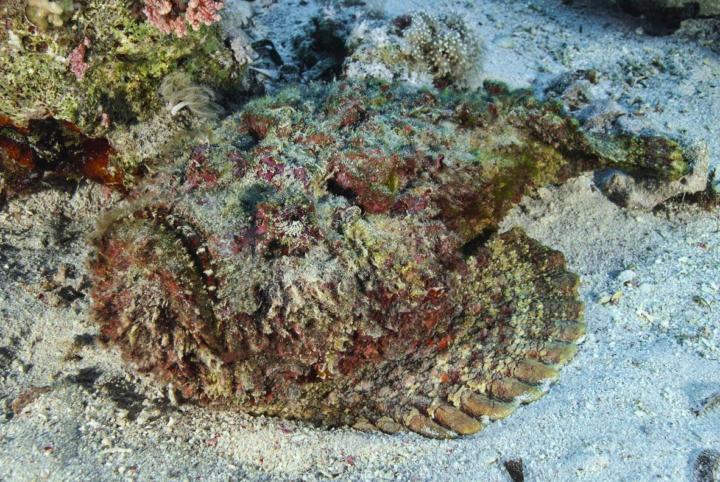
Of all the different species of fish there are only a few which can be described as venomous, and most of these are not particularly dangerous. The main exception to this rule are those of the scorpionfish family. These include the stunning lionfish and the stunningly ugly stonefish.
It is the stonefish (Synanceia) which is considered most dangerous. Armed with 13 needle-sharp spines on its back and a powerful neurotoxin the stonefish seems to revel in lurking around the shoreline just waiting for someone to stand on it. And when they do, they know about it! [11]
The sting is said to be so painful that victims have begged to have their leg cut off. One person described the sting as feeling like “having each knuckle, then the wrist, elbow and shoulder being hit in turn with a sledgehammer over the course of about an hour“.
If untreated the sting can be fatal. Fortunately an effective antivenom has meant that no one in Australia has died from a sting in nearly 100 years.
The Blue-ringed octopus is one of the ocean’s most unassuming killers. These little octopuses with their iridescent blue rings have a particularly dangerous toxin in their venom – TTX. This is the same poison as is found in pufferfish and arrow poison frogs and is over 1,000 times stronger than cyanide. [12] There is no known antivenom to the blue-ringed octopus bite and the powerful neurotoxin can rapidly paralyse the respiratory system. In cases of severe envenomation the only treatment is to put the victim on life support until they can breathe for themselves.
One of the most toxic animals in the oceans is the cone snail. These pretty little molluscs are armed with a hollow barbed harpoon which is capable of delivering the strongest venom known of any creature. It has been calculated that a single drop of this deadly conotoxin would be enough to kill 20 adult humans [13]. Unlike the sea creatures above the cone snail uses its venom to hunt its prey. The good news is that as a snail it doesn’t move very fast!
Another sea creature that is equally happy using its venom for hunting and defense is the box jellyfish. There are actually quite a few species of box jellyfish but all are armed with thousands of tiny stinging cells and strong venom. Of all these it is the Australian sea wasp (Chironex fleckeri) which is considered the most dangerous [14]. Not only is it large in size but has the second most powerful venom of any creature on Earth. A single individual of this species has venom powerful enough to kill 60 adults. Whilst many of the creatures on this list are purely a theoretical danger box jellyfish have been responsible for many deaths over the years and countless painful stings.
Venomous Mammals?
Most people, myself included until recently, have no idea that there is any such thing as a venomous mammal. Well there are quite a few in fact. Whilst some just use poisons from plants and prime their claws in this manner, others actually genuinely produce their own venom.

Given its many other bizarre characteristics it is not completely surprising that as well as being half bird, the duck-billed platypus also stings like a bee! The male platypus is armed with a set of tough “spurs” on its hind legs. These have a groove in them which channels venom produced in the crural glands to the sharp tip which is used to inject the toxin [15].
It is thought that the platypus uses its sting primarily against rival males and it is known that the peptide toxin is more concentrated during the breeding season. However, enough people have been stung over the years to know that this is an experience to avoid.
The venom is not regarded as lethal to humans but is reported to cause sufficiently excruciating pain to incapacitate the victim. The pain is not only immune to the effects of morphine but can last for weeks. One victim, Keith Payne, a former soldier and recipient of the Victoria Cross described the pain as worse than being hit by shrapnel.
Another group of venomous mammals are several members of the shrew family. Now, how and why these little mouse-like creatures came to be venomous is the topic of some debate, but what may surprise many is that shrews are in fact partly carnivorous. They will in fact eat mice, fish, frogs and other small vertebrates.
It is suggested that the shrew’s venom helps it hunt these larger animals and there is some support for this. Delivered via its grooved incisor teeth the venom of one American short-tailed shrew is sufficient to kill 200 mice [16].
Possibly the cutest animal on this list is the slow loris. Found in the forests of south-east Asia these small primates are unusual in a number of respects not least because they are possibly both poisonous and venomous [17]. The slow loris secretes a kind of alkaloid toxin from a gland near their armpit. This is used in two ways; firstly they will lick the secretion onto their young which makes them poisonous to predators. The toxin may also be transferred via biting making it a venom. Lorises are renown for not letting go once they bite which is thought may help maximise the transfer of toxin. Not a great deal is understood about the nature of the toxin. Some research suggests it may be acquired from ants and centipedes in the loris’ diet and that it only becomes fully activated when mixed with saliva.
Most Venomous Lizards
Just for a change we have moved away from Australia, which apparently has no dangerous venomous lizards. There are very few truly venomous lizards which is mildly surprising given the number of venomous snakes. Until a few years ago it was thought that there were only two venomous lizard species, however recent studies have shown there are more, just they aren’t dangerous to humans.
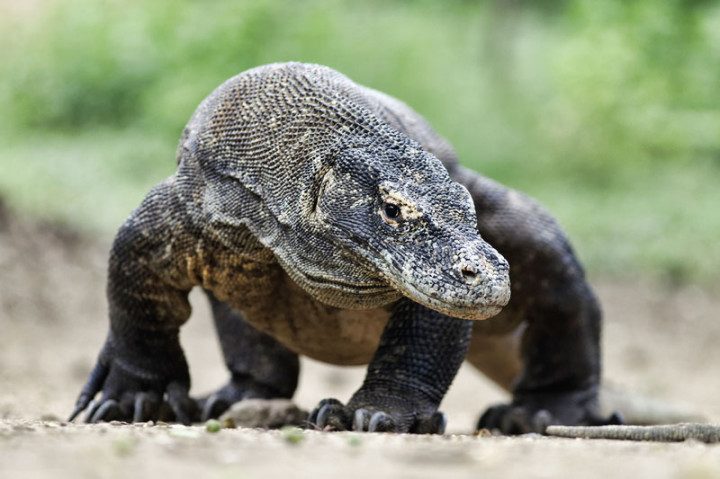
If there was any lizard you wouldn’t want to be venomous it would be the biggest and meanest of them all, the Komodo dragon. Until 2009 nobody actually knew that the Komodo dragon was indeed venomous. Researchers believed this giant lizard’s preferred method of killing relied on a single bacteria infested bite which infected the prey animal. The Komodo dragon would then stalk the victim like the shadow of death until it collapsed up to several days later.
However, Australian biologist Bryan Fry found evidence that the Komodo actually possesses venom which it secretes from glands in its mouth. The venom contains some compounds in common with that of the Inland Taipan which cause a rapid decrease in blood pressure and shock. Whilst the delivery mechanism may not be as effective as a snake a mauling from a Komodo dragon is likely to introduce enough venom. [18]
Komodos have proved deadly in the past but the venom is actually a lot less effective on humans than it is on their normal prey.
Perhaps the most venomous lizard to humans is the Gila Monster of the Mexico / US deserts. Again the Gila Monster doesn’t have the hypodermic fangs of a snake and instead relies on grooves in its teeth to conduct the flow of the venom. Given that this neurotoxin is as potent as that of the deadly coral snake it is fortunate that this is the case.
The immediate symptoms of the bite are intense pain and feeling faint due to dropping blood pressure. Further reactions may include bulging of the eyes and internal haemorrhaging. Fortunately there have been no recent reports of fatal bites. [19]
Most Venomous Snakes
Of all the animals on Earth it is the snakes that are most strongly associated with venom. There is good cause for this, the snakes have not only some of the strongest venom of all and the most perfectly evolved delivery system. This deadly combination has proved sickeningly effective with no other type of animal causing more deaths than snakes (except other humans). One study suggests between 50,000 and 100,000 deaths a year are caused by snakes.

Whilst this article is about the most venomous animals on the planet it is interesting to note that the snake with by far the strongest venom of them all has been responsible for very few deaths. Also known as the Fierce snake on account of its formidable venom is the Inland Taipan.[20]
This snake is fast, accurate and nearly always serves up venom with its bite so it is fortunate that it is resident of the parched deserts of central Australia. On average the Inland Taipan has enough venom to kill 100 men with a bite being potentially lethal within 45 minutes. If untreated with anti-venom the fatality rate is 80%. Not only is the venom a powerful neurotoxin, it also contains myotoxins which break down tissue and anticoagulants that cause internal haemorrhaging.
The same is true for many of the sea snakes. These have incredibly potent venom but rarely bite humans. Of all these snakes it is Dubois’ sea snake that has the most deadly venom, but still not as strong as the Inland Taipan.
A much more dangerous snake is the Inland Taipan’s cousin, the Coastal Taipan. Although this snakes venom is significantly weaker than its inland counterpart the coastal taipan is larger, much more aggressive and capable of delivering a much greater amount of venom in a single bite. One source claims a single bite contains sufficient venom to kill 59 men and the untreated fatality rate is 100%. [21]
Statistically, the most dangerous snake in the world would have to be one of the “big four”, the four species of Indian snakes that are responsible for the most deaths. They are the Indian cobra, Common krait, Russell’s viper and Saw-scaled viper.
References
| ↑1 | What is a LD50 and LC50?|https://www.ccohs.ca/oshanswers/chemicals/ld50.html |
|---|---|
| ↑2 | Bite or be bitten: What is the difference between poison and venom?|https://www.nhm.ac.uk/discover/bite-or-be-bitten.html |
| ↑3 | Schmidt sting pain index|https://en.wikipedia.org/wiki/Schmidt_sting_pain_index |
| ↑4 | An overview of Phoneutria nigriventer spider venom using combined transcriptomic and proteomic approaches|https://www.ncbi.nlm.nih.gov/pmc/articles/PMC6070231/ |
| ↑5 | Sydney funnel web spider, Atrax robustus|https://biomedicalsciences.unimelb.edu.au/departments/department-of-biochemistry-and-pharmacology/engage/avru/discover/spiders/funnel-web-spiders-atrax-robustus-and-hadronyche-sp. |
| ↑6 | Envenoming and antivenom use in Australia|https://pubmed.ncbi.nlm.nih.gov/9792162/ |
| ↑7 | Scorpion Envenomation|https://emedicine.medscape.com/article/168230-overview?form=fpf |
| ↑8 | The Atlas of the World’s Most Dangerous Animals|https://books.google.co.uk/books/about/The_Atlas_of_the_World_s_Most_Dangerous.html?id=jTRxvk2O-QAC&redir_esc=y |
| ↑9 | https://earthlingnature.wordpress.com/2018/01/19/friday-fellow-deathstalker/ |
| ↑10 | Hottentotta tamulus – Wikipedia|https://en.wikipedia.org/wiki/Hottentotta_tamulus#Toxicity |
| ↑11 | Stonustoxin Is a Novel Lethal Factor from Stonefish (Synanceja horrida) Venom|https://www.sciencedirect.com/science/article/pii/S002192581978329X |
| ↑12 | Tetrodotoxin, an Extremely Potent Marine Neurotoxin|https://www.ncbi.nlm.nih.gov/pmc/articles/PMC4626696/ |
| ↑13 | Some cone snail’s venom is thousand times more powerful than morphine|https://utmsi.utexas.edu/blog/entry/some-cone-snail-s-venom-is-thousand-times-more-powerful-than-morphine |
| ↑14 | Box Jellyfish – National Geographic|https://www.nationalgeographic.com/animals/invertebrates/facts/box-jellyfish |
| ↑15 | Wide world of venom – the platypus|https://biomedicalsciences.unimelb.edu.au/departments/department-of-biochemistry-and-pharmacology/engage/avru/blog/wide-world-of-venom-the-platypus |
| ↑16 | Short-tailed Shrew|https://www.esf.edu/aec/adks/mammals/shorttailed_shrew.php |
| ↑17 | Mad, bad and dangerous to know: the biochemistry, ecology and evolution of slow loris venom|https://jvat.biomedcentral.com/articles/10.1186/1678-9199-19-21 |
| ↑18 | Venom is key to Komodo dragon’s killing power|https://www.newscientist.com/article/dn17156-venom-is-key-to-komodo-dragons-killing-power/ |
| ↑19 | National Geographic – Gila Monster|https://www.nationalgeographic.com/animals/reptiles/facts/gila-monster |
| ↑20 | Inland Taipan – The Australian Museum|https://australian.museum/learn/animals/reptiles/inland-taipan/ |
| ↑21 | Coastal taipan – Australian Geographic|https://www.australiangeographic.com.au/fact-file/coastal-taipan/ |

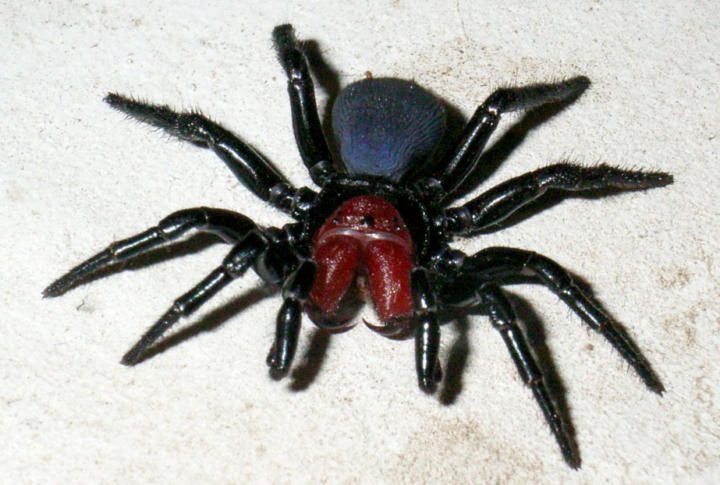

I love frogs! There so cool! Evan Poisonous Dart frogs. I like the Strawberry poison dart frog. I love the colors.
Um…..okay
Is there even a Strawberry poison dart frog?
Yes, the strawberry poison dart frog does indeed exist.
Bruh i’m going to have night mare of Spiders
You’ve gotta love Australia don’t you??? What a crazy place! The strange thing being that there are all of these incredibly dangerous creatures, yet there aren’t any large mammals; so why did so many creatures develop such toxic venoms? I guess I may have answered my own question now that I think about it; perhaps all the large mammals were killed off by the venomous creatures!?
😛
Australia has salt-water crocodiles, animals that make tigers look safe by contrast. After that its biggest land predators are in turn freshwater crocodiles (not especially dangerous), humans (enough said), and dogs or dingoes (the difference between the two is slight).
Really-effective venom takes millions of years to develop, and the newest venoms that can reliably kill people are those of snakes, which go back to just after the demise of the dinosaurs. Let’s consider that some of the deadliest venoms belong to spiders, mollusks, and jellyfish that have been around back to nearly the dawn of life. Developing a dangerous chemical isn’t hard, but being able to evolve to hold it safely is even trickier.
Many of the deadliest venoms belong to some of the most fragile of species, including spiders and scorpions.
Interesting article though you got confused with the black widow and red back. The red back lives in Australia, not the black widow and it’s the red back that is responsible for over 10,000 bites per year.
The stories of red backs living under outside toilet seats are true as my dad was bitten by one when he was a young boy.
An interesting fact regarding the funnel web is that the male is more venomous than the female – up to 5 times.
Where is the box jelly fish? It has the most toxic venom of animal on earth bar none.
It’s there – under sea creatures (doh!). And I think you’ll find it is has the second most toxic venom on earth…
There are more than one species of box jelly fish. The small one , begins with an I has the most deadly venom
Irukandji. Couldn’t find the actual figures for the strength of their venom
Ok. So for now cone snail
This list was accurate in some parts, but VERY wrong in the part about snakes. You made a claim that the Fierece snake is the most venomous.. I also found it funny how you made a mention of the sea snake, and still said the venom of the Fierece snake is more.. I would like you to read up on the Belcher’s sea Snake. This snake really is the most venomous of all snakes, and yes that does include the the Fierece snake. The venom of the Belcher’s sea snake is second only to the irukandji jellyfish.. The irukandji isaactually the most toxic jellyfish, which would actually make it the most toxic of anything.
No, the article is correct. Facts are cross referenced, unlike yours I imagine. Start here: https://en.wikipedia.org/wiki/Inland_taipan#Venom you can read up on the citations if you think Wikipedia isn’t reliable enough.
Also I don’t think the irukandji has the most powerful venom of any jellyfish, that would be one of the Chironex box jellyfish.
U see. U can’t trust wikipedia because it can be edited
Wikipedia is not a valid source, as anyone can edit information
Yes, but the citations from reputable academic sources are valid. Which is exactly what I said in the previous reply… bangs head against wall…